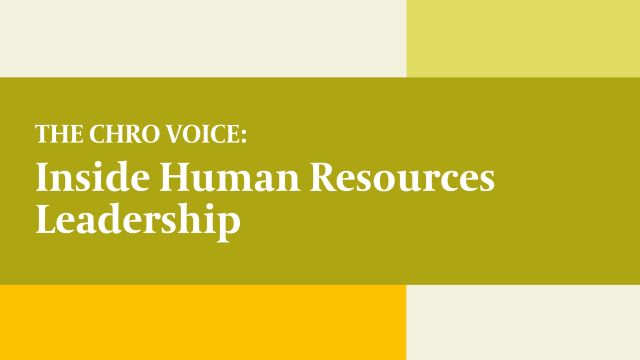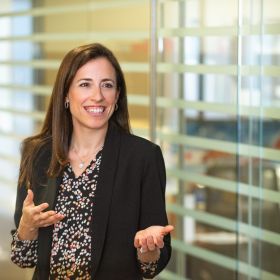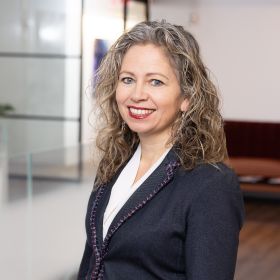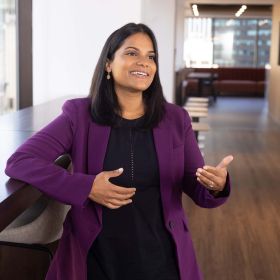I go after things that drive real impact. In HR, I have a framework to identify the three things that will take the company forward. The company's needs come first, then the CEO and leadership.
 Avani Solanki PrabhakarChief People Officer at Atlassian
Avani Solanki PrabhakarChief People Officer at Atlassian
Two college friends, Mike Cannon-Brookes and Scott Farquhar set out to create Atlassian in 2002 with just a dream and a credit card. Today, Atlassian Corporation, an Australian-based software company that specializes in collaboration tools, has offices in fourteen countries and over 12.000 employees.
We sat down with Chief People Officer, Avani Prabhakar, to find out how she leads Atlassian’s HR arm to keep delivering on its mission to unleash the potential of every team. Prabhakar also shared much of her wisdom in a new Ted Talk, “How Distributed Work Can Unlock Your Potential.”
What has been your career trajectory, how did you get in HR, and what led to where you are now?
I'll be honest. Indian parenting is about going to the best school, the best university, and getting the best campus placement. That was my journey until I landed at GE, my first job. At GE, they design your career by making you work in various departments before you actually get to HR. I worked in GE Analytics, financial planning, and the Energy Turbine section, learning how a turbine works and doing pricing. It was exciting. When I finally got to HR, I gravitated towards the business partnering aspect. Even back then, when business partnering wasn't a thing, I was more ingrained on the business side, which helped me do my HR job more effectively. At GE, we were hiring close to 100,000 people annually. It was a period of exponential growth.
From 2000 to 2007, I worked at GE Capital International Services in India. One of my ex-bosses advised me to try a different industry to become a well-rounded HR professional. British Airways happened. I met someone, had a chat, and next thing I knew, I was there for seven years. And it was a totally different experience. British Airways had generations of people working in the same organization. It was a different experience, but now I see the value in it.
Summing up, my BA experience was more international. I looked after EMEA, the Middle East, India, South Asia, and Asia-Pac. This gave me a broader international experience, working in a different industry and going through massive change management, including mergers and acquisitions. My biggest learning was dealing with unions. This gave me a grounded experience of what real change management means in a tough environment. In my personal life, I had my daughter when I was 27 1/2. When she was two years old, I was traveling all over the world. When she was six or seven, I realized I needed to rethink my career. I'd lived in London, Singapore, and the US. I fell in love with Australia while working with Qantas and British Airways. I decided to move there to raise my family. Since then, Australia has been home. Fuji Xerox was a unique experience, a Japanese-American company with an American MD, a Japanese chairman, and Australian leadership. It was an industry struggling to shift from hardware to software, highly sales focused. I was closely embedded with the sales and marketing side.
At Atlassian, I got a call six years ago. I didn't know much about Atlassian, but after going through the selection process and meeting the team, I knew these were the people I wanted to work with. My career trajectory at Atlassian has been about solving the most challenging problems, not about titles. I want to live for the moment and enjoy what I'm doing. This has unlocked a different side of me, and I feel like I've found my tribe.
You seem to have always done things in alignment with your values. Tell me about your values and how they align with what you do at Atlassian?
I go after things that drive real impact. In HR, I have a framework to identify the three things that will take the company forward. The company's needs come first, then the CEO and leadership. This gives me the courage to stand up to the CEO if necessary. I try to speak only when necessary. This focus allows me to make relevant points that add value. I'm very direct and not a traditional HR person. I call things as they are, which may be politically incorrect, but it's honest. I'm highly opinionated and move fast. I believe in providing clarity quickly, even if it means challenging traditional people management approaches. My team knows I speak last in meetings, only if necessary, to ensure the conversation is on the right track.
I call things as they are, which may be politically incorrect, but it's honest. I'm highly opinionated and move fast. I believe in providing clarity quickly, even if it means challenging traditional people management approaches.
Avani Solanki PrabhakarChief People Officer at Atlassian
Let's pivot to the big problems you have been most excited to solve at Atlassian and specifically how you have seen the HR role evolve to help reach those solutions?
I would say the role of HR has been evolving, and it is different for different industries based on which client group you are supporting. But three things I've held very true to myself and my team are: as an HR person, you should understand your products really well, like any product person would. Second, you should understand our customer base really well. Not just knowing the customers but understanding which markets we are targeting and the leap from tech users to non-tech users. Third, how does all of this translate into P&L? You should be able to read a P&L, understand the rule of 40, and the margins we are trying to achieve to make the business successful.
These three pillars have been fundamental to me, and I believe any good HR person should have them. Once you know these things, it gives you the respect to be at the table to talk about people implications and strategy. Without this knowledge, you can't effectively discuss talent strategy. More HR folks are coming from non-HR backgrounds, which gives them a different perspective. The pride of owning the HR craft needs to go away. HR should become a business function embedded into the business, like strategy or biz ops. In my organization, we work in squads at all levels, with an HR business partner working with the teams. This model ensures HR is deeply embedded in the business rhythms where actual work happens.
Tell me about how you designed your HR organization?
We have HR business partnering as the driving force. My bar is very high for HR business partners on business acumen, agility, and proactivity. We still have specialized teams for comp and benefits, talent, and recruitment. What we've done differently is create pods for each org, led by an HRBP, with dedicated comp and benefits partners and talent partners embedded into the business. This model ensures alignment with the business needs. We work in a squad model where HRBPs are part of the decision-making process at the ground level.
I want to take us back to the three pillars for a second. How have you deepened your understanding of these pillars as an HR leader?
It starts with going deep and doing a bottoms-up approach. I spend a lot of time in the right Slack channels, looking at feature roadmaps, and staying updated on product content. For customers, I have a goal to meet at least two customers a month, and I encourage my team to do the same. For P&L, I bring finance folks to team meetings for education and regularly discuss investor sentiment. I ask my team for business updates, not just team updates, to stay informed about new launches and market sentiment. You have to show it by example and dedicate time to it.
This sounds like what you describe in you in your Ted Talk as a “grinder mentality” which, by my understanding, means putting in the hard work to know the business bottom-up and top-down.
Yes, that's true. And if you talk to people in the business, they're always willing to share. You need to make the time.
As an HR leader how have you seen the expectations of employees from employers changed over time, even in the time you've been at Atlassian?
The world has dramatically changed in the last five years, and COVID is just one aspect. There have been many crises, like those in Israel, Hamas, and Afghanistan. With a global employee population becoming more aware, expectations have shifted. It's no longer just about benefits; employees want to know what the company stands for. They want to see how you react in crises and the broader impact you drive as a company. The pandemic allowed people to check the character of companies—whether they stood behind policies or did what was necessary for employees. Since then, we've faced one crisis after another, and employees' expectations have evolved. They want to know your stance on global issues, like the Ukraine war, and whether you align with company values.
With a global employee population becoming more aware, expectations have shifted. It's no longer just about benefits; employees want to know what the company stands for. They want to see how you react in crises and the broader impact you drive as a company.
Avani Solanki PrabhakarChief People Officer at Atlassian
Transparency and openness are also crucial. Employees need to know the how and why of every decision. Companies must build the muscle to explain decisions clearly and honestly. Employees appreciate honesty and vulnerability, even if it means admitting you can't take a stand on certain issues. The geopolitical uncertainty impacts employees' expectations, and companies must consider this.
What distinguishes Avani as an HR leader
We have been following Avani and her impressive career for some time. Beyond giving you a taste for her incredible business insight and human wisdom in the above interview, we thought it would helpful to outline for our readers just what has made her such an extraordinary HR leader. Here is what we have observed:
- Business Acumen: She really stresses the importance of understanding the company's products, customer base, and financial aspects, including P&L and investor sentiment. She believes that HR leaders should be deeply embedded in the business and work closely with teams to understand business rhythms.
-
Proactivity and Agility: Avani also values proactivity and agility in HR, ensuring that her team is always ahead of the curve and responsive to the dynamic needs of the business. She focuses on embedding HR business partners in squads to ensure they are involved in decision-making processes and closely aligned with business goals. -
Direct Communication: Avani is widely known for her direct communication style, avoiding traditional HR speak and being straightforward about issues. She values honesty and transparency, which helps build trust and clarity within the organization. -
Focus on Impact: Avani prioritizes working on projects that drive real impact. She has a framework to identify high-priority items that will significantly advance the company. This focus on impactful work ensures that her efforts and those of her team are aligned with the company's strategic goals. -
Customer and Market Focus: She ensures that her team understands the customer landscape and market dynamics. She sets goals for her team to meet with customers regularly and stay updated on market trends, which helps them align HR strategies with business needs. -
Adaptability to Change: As her own career trajectory demonstrates, Avani has demonstrated adaptability by working in various industries and roles, from GE to British Airways to Atlassian. Her diverse experience has equipped her with a broad perspective and the ability to handle different challenges effectively.
Overall, Avani Prabhakar’s example offers an inspiring model for truly impactful HR leadership across the world at large.











